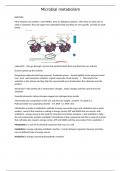Microbial metabolism
ENZYMES
Most enzymes are proteins ( some RNAs), they are biological catalysts , they have an active site at
witch a substrate ( they are larger than substrates) binds and they are very specific and rely on weak
bonds .
Induced fit – they go through a proces that perfectly binds them and then they can activate
Enzyme speeds up the reaction
Nonprotein molecules that help enzymes Prosthetic groups – bounds tightlty to the enzyme (metal
ions , iron) and coenzymes (vitamins, organic molecules, binds loosely ) – they bind to the
substrate or the activee site they help the enyme build up or breaks down the substrates into the
product
Denatured- if the perfect ph or temperature changes , shape changes and they cant bind to the
substrate
Essential elements: carbon,nitrogen,oxygen,iron,hydrogen,trace metals
Macromolecular composition of the cell and their dry weight : proteins -55, lipids-9.1,
Polysaccharide-5.0, Lipopolysaccharide – 3.4, DNA- 3.1, RNA- 20.5 .
Metabolism is made of catabolism( cell take a energy source like sugar and catabolises into a waste
product cause of this reaction is making of energy carriers ATP and NADH that are recycle with
anabolism , energy source is also used for movement and active transport ) and anabolism ( make
the cell components, proteins and lipids= biosinthesis of this compounds and this is made of nutriens
that cell takes also requires energy carriers ATP and NADH and they are produce from catabolism )
Metabolism is a sum of all chemical reaactions that occur in a cell
Catabolism is energy releasing metabolic reaction , it varies between organisms because microbes
can use different type of energy source
Anabolism is energy consuming biosynthetic reactions
, Microbial metabolism
Type of the metabolism
If an
organism is a
heterotroph, its cell carbon is obtained from
one or another organic compound. An autotroph, by contrast,
uses carbon dioxide (CO2) as its carbon source. Chemoorganotroph are by definition heterotrophs ,
Autotrophs are called primary producers due to thyem synthesizing new organic matter from
inorganic carbon.
Calvin cycle – phototrophic organism incorporate CO2 into cell material
Questions from book
1. How does chemoorganotroph differ from a chemolithotroph
2. A chemotroph from phototroph
3. Autotroph from heterotroph
Goal is to convert the energy source into ATP and ATP comes from the chemical reaction
1 law of thermodynamics – Energy can be transformed from 1 to 2 form but cant be generated or
destroyed
Energgy required for making ATP comes from chemical reactions catalyzed by enzymes
Energy is measured in kJ
Free energy is the energy available to do work. Free energy released during a reaction can be
conserved by cells in the form of ATP and a handful of other energy-rich substances.
The change in free energy during a reaction is expressed as AG0, where the symbol A( delta ) is read
as “change in.” The “0” and “prime” .
If the ¢G09 for this reaction is negative in arithmetic sign, then the reaction will proceed with the
release of free energy; such reactions are said to be exergonic. However, if ¢G09 is positive, the
reaction requires energy in order to proceed and such reactions are endergonic. Thus, exergonic
, Microbial metabolism
reactions release free energy( can be a energy source for a cell) whereas endergonic reactions
require free energy.
Exergonic- can be used to make ATP
Endergonic- they require ATP to work because they require energy
If AG0 = 0 the reaction is in equilibrium and nothing happens
Free energy calculation - know the free energy inherent in the reactants and products of
the reaction this calculation doesn’t tell us the rate only telss us if the energy is released or
required . Rate is a combination of thermodynamics AG0 and kinetics ( velocit of catalysis)
Coupling-
Activation energy- minimum energy required for chemical reaction to begin
Questions from book
1. What is free energy
2. Does glucose formation from the element release or require energy
3. Funcion of catalyst , what are enzymes made of
4. Where does substrate bind
5. What is activation energy
Donor and acceptors
Cells conserve energy released from exergonic reactions by coupling the reaction to the
biosynthesis of energy-rich compounds, such as ATP. Reactions that release sufficient energy to
form ATP require oxidation–reduction biochemistry. An oxidation is the removal of an electron (or
electrons) from a substance, and a reduction is the addition of an electron (or electrons) to a
substance. In microbiology, the term redox is used as shorthand for oxidation–reduction
Redox reaction is transfering electrons between 2 molecules there are donors (oxidized ) and
acceptors ( gets reduced) , oxidized form on the left
E0 – reduction potential tells about the tendency to donate or accept electrons





